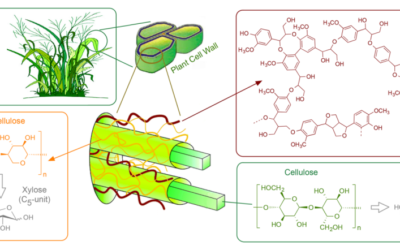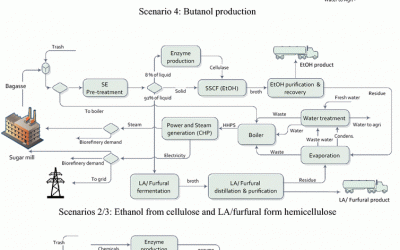
Molar carbon selectivities for different renewable petroleum refinery feedstocks (Source: Olcay et al.)
Researchers develop four-step catalytic process to produce petroleum refinery feedstocks from biomass sugars
3 January 2013 – A team of researchers led by James Dumesic and George Huber, both now at the University of Wisconsin-Madison, have demonstrated how C5 sugars derived from hemicellulose can be converted into a high-quality petroleum refinery feedstock via a four-step catalytic process. An open-access paper on their work is published in the RSC journal Energy & Environmental Science.
The renewable petroleum feedstock comprises normal, branched and cyclic alkanes up to 31 carbons in length and is similar in composition to the feedstocks produced in a petroleum refinery from crude oil. The new process can be tuned to adjust the size of the liquid alkanes.
These renewable feedstocks can be further processed in existing petroleum refineries to make common refinery products. These feedstocks have no olefinic or heteroatom content, and contain almost no aromaticity. This will help eliminate the expensive hydrotreatment processes downstream in the petroleum refineries, and reduce combustion-related air pollutants, the researchers noted.
Advances are being made worldwide that allow us to more efficiently convert our renewable resources into a range of liquid transportation fuels. Most of these processes produce single-component fuels like ethanol, butanol, dimethylfuran, alkyl esters, and a narrow distribution of straight-chain alkanes. However, gasoline, diesel and jet engines are manufactured to be used with petroleum-derived fuels that are mixtures of compounds having a range of boiling point fractions, combustion properties, and physical properties. Furthermore, most of the previous processes produce renewable fuels that can only be used in gasoline engines.
The purpose of this paper is to demonstrate a process for the production of a high-quality renewable petroleum refinery feedstock from C5 sugars that is a mixture of compounds similar in composition to streams inside the petroleum refinery today. This synthetic renewable petroleum feedstock could be seamlessly integrated into existing petroleum refinery producing jet, diesel and gasoline. This integration would allow us to use our existing petroleum refinery infrastructure more efficiently thereby allowing us to more rapidly accelerate our society’s move to a renewable transportation economy. Unlike Fischer–Tropsch synthesis, which produces liquid fuels at costs of greater than $5 per gallon of gasoline energy equivalent, this approach does not require an expensive gasification step.
Earlier, they had developed a four-step catalytic process for converting carbohydrates into liquid alkanes with carbon numbers ranging between 7 and 15. This process involved: (1) dehydration of carbohydrates into furfural and 5- hydroxymethylfurfural (HMF); (2) aldol condensation reaction of furfural and HMF with acetone; (3) low-temperature hydrogenation step; and (4) high-temperature hydrodeoxygenation.
Subsequently, they showed that process could convert an aqueous hemicellulose stream, derived from wood, into a liquid product that is primarily tridecane (n-C13) which could be blended into jet or diesel fuels. These waste hemicellulose sugars are among the most inexpensive biomass feedstocks that are available today, they noted. Preliminary economic analysis suggests that tridecane could be produced at costs of less than $3.00 per gallon in a large integrated biorefinery. However, the drawback to this is that only a single-component fuel is produced.
In the new work, they scaled up the tridecane process and adjusted the chemistry to produce a mixture of different hydrocarbons including n-paraffins, isoparaffins and naphthenes (cyclic alkanes) with carbon numbers from C1 to C31. The overall process comprises four basic steps:
- The production of furfural—a highly promising feedstock for biofuel production—from the acid-catalyzed dehydration of hemicellulose-derived sugar streams in a biphasic reactor.
- The aldol condensation of furfural with acetone to produce highly conjugated C13 compounds along with some oligomeric adducts.
- Hydrogenation of the step 2 products in the presence of a Ru/Al2O3 catalyst. In this hydrogenation process heavy cyclic molecules are also formed by cycloaddition reactions (i.e. hydrocycloaddition).
- Hydrodeoxygenation and isomerization using a Pt/SiO2–Al2O3 bifunctional catalysts to produce petroleum refinery feedstocks, or more specifically, fluid catalytic cracker cycle oil substitutes, having carbon numbers up to C31.
A simple biorefinery model shows that about 55% of a furfural–acetone mixture (10:3 wt ratio) can be converted into cycle oils while also producing other refinery products such as gasoline and natural gas.
They also observed the formation of higher alkane products than C13 from furfural-derived feeds, at relatively lower yields (up to 26%), using the original integrated process described earlier.
Biomass-derived hemicellulose extracts are composed mainly of xylose molecules which are 5-carbon sugar monomers. In order for them to be converted into diesel and jet fuels, these molecules need to undergo carbon–carbon coupling reactions. One way of achieving this coupling is through the aldol condensation of xylose-derived furfural molecules with acetone. The resulting highly functional C13 compound can be used as a tridecane precursor which is a normal alkane in the range of jet and diesel fuels. The further processing of this precursor includes utilization of a low-temperature hydrogenation step for saturation of the double bonds and a high-temperature deoxygenation step which removes the oxygen content in the form of water.
Here we have shown how this process can be modified by the inclusion of other types of carbon–carbon coupling reactions such as oligomerization reactions (e.g. Michael addition and radical polymerization) and cycloaddition reactions (e.g. Diels–Alder reactions). The end product is a mixture of hydrocarbons, composed mainly of normal, branched and cyclic alkanes of up to C31, which can replace today’s petroleum refinery cycle oils.
While this work was done using homogeneous catalysts, the authors said that new generations of solid heterogeneous catalysts might more efficiently convert biomass resources into these targeted products. These new catalysts, they suggested, will likely be developed by understanding the fundamental chemical reactions, developing new synthesis techniques, using modern computational tools, and using in situ spectroscopy techniques.
They also suggested that in the future this technology might be extended to also convert C6 sugars and lignin to renewable petroleum feedstocks as well.
Resources
- Hakan Olcay, Ayyagari V. Subrahmanyam, Rong Xing, Jason Lajoie, James A. Dumesic and George W. Huber (2013) Production of renewable petroleum refinery diesel and jet fuel feedstocks from hemicellulose sugar streams. Energy Environ. Sci. 6, 205-216 doi: 10.1039/C2EE23316A
an interesting concept!





